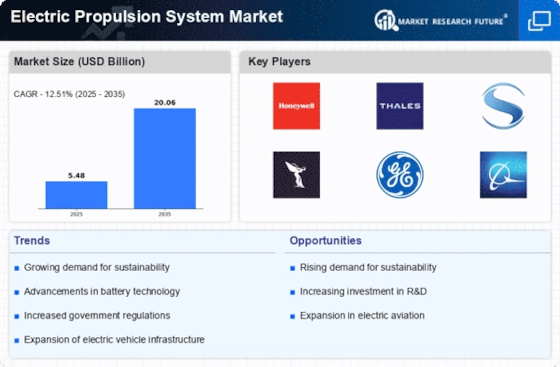Regulatory Support and Incentives
Government regulations and incentives are increasingly shaping the Electric Propulsion System Market. Many governments are implementing policies aimed at promoting the adoption of electric propulsion technologies, including tax incentives, subsidies, and stricter emissions standards. These regulatory frameworks are designed to encourage manufacturers and consumers to transition towards electric solutions. For example, several countries have set ambitious targets for phasing out internal combustion engines, which is expected to drive demand for electric propulsion systems. The supportive regulatory environment is likely to facilitate market growth, as it creates a favorable landscape for innovation and investment in electric propulsion technologies.
Advancements in Battery Technology
Technological innovations in battery technology are playing a crucial role in the Electric Propulsion System Market. Enhanced energy density, reduced charging times, and improved lifecycle performance of batteries are making electric propulsion systems more viable for a range of applications. For instance, advancements in lithium-ion and solid-state batteries are expected to drive the market forward, as they offer higher efficiency and safety. The market for electric propulsion systems is anticipated to benefit from these developments, with battery technology improvements potentially leading to a 20% increase in system efficiency. This evolution in battery technology is likely to attract more investments and foster further innovation in the electric propulsion sector.
Rising Demand for Clean Energy Solutions
The Electric Propulsion System Market is experiencing a notable surge in demand for clean energy solutions. This trend is largely driven by increasing awareness of environmental issues and the need to reduce greenhouse gas emissions. As countries strive to meet international climate agreements, the adoption of electric propulsion systems in various sectors, including transportation and aerospace, is becoming more prevalent. According to recent data, the electric propulsion system market is projected to grow at a compound annual growth rate of approximately 15% over the next five years. This growth is indicative of a broader shift towards sustainable energy sources, which is likely to reshape the energy landscape significantly.
Increased Investment in Electric Mobility
The Electric Propulsion System Market is witnessing a significant increase in investment directed towards electric mobility solutions. Major automotive manufacturers and tech companies are allocating substantial resources to develop electric vehicles (EVs) and associated propulsion systems. This trend is supported by a growing consumer preference for sustainable transportation options. Recent reports indicate that investments in electric mobility are expected to exceed $300 billion by 2030, reflecting a robust commitment to transitioning from traditional combustion engines to electric alternatives. This influx of capital is likely to accelerate the development and deployment of electric propulsion systems, thereby enhancing their market presence.
Growing Applications in Aerospace and Marine Sectors
The Electric Propulsion System Market is expanding its reach into diverse applications, particularly in the aerospace and marine sectors. The increasing need for efficient and environmentally friendly propulsion systems is prompting industries to explore electric alternatives. In aerospace, electric propulsion systems are being integrated into urban air mobility solutions and electric aircraft, while in the marine sector, electric propulsion is gaining traction in ferries and cargo ships. This diversification is expected to contribute to a market growth rate of around 12% annually over the next decade. The exploration of electric propulsion in these sectors indicates a broader acceptance and potential for innovation, further solidifying the market's trajectory.


















Leave a Comment